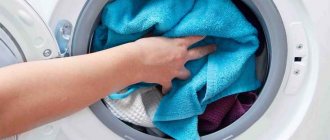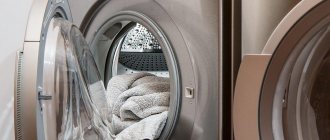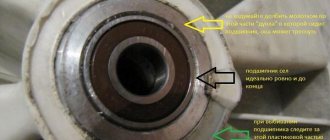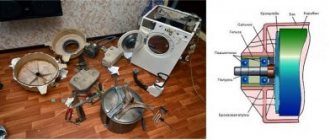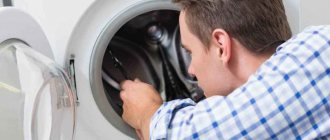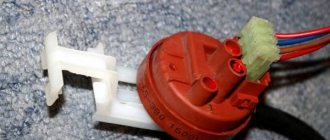Published: 20 Dec 2020
You threw things into the washing machine, turned on the wash and forgot about it for a while, because the automatic equipment does not require attention until the end of the work. But this time, when you went to the washing machine to take out and hang up the clean clothes, you discovered that the washing machine had frozen.
The washing machine can stop at any time, both at the beginning and at the end of the wash; it can stop during rinsing or when it starts spinning. In most cases, equipment owners turn to us for help when the SMA freezes during the spin cycle.
Simple faults
During the washing process, the washing machine may freeze and stop. There are various reasons for equipment failures. Next, we will consider the most common causes of simple machine failures.
The weight of the laundry exceeds the norm
Some modern washing machine models are equipped with an intelligent sensor that monitors the weight of the laundry in the drum. If the machine stops, you need to remove some of the laundry from the washing machine drum and start the wash again.
What if there was an error in choosing the washing mode?
This may cause problems with the washing machine's electronics. Quite a simple mistake, but can cause serious problems.
Don’t forget that before you start using the washing machine, you need to carefully read the instructions and only then start using it.
The instructions describe in detail all washing modes and programs, why each is needed and how to use it. And if the washing process suddenly stops, it is better to read the instructions again.
For example, if you select the “soaking” mode and then “bleaching”, the machine will not complete all washing modes, but will stop in the middle. Under no circumstances should you run two such modes: “soaking” and “whitening”. It is forbidden.
But if the modes were started and the machine left the washing process, then you should immediately seek help from a qualified technician. You should not look for a solution to the problem on your own. This may take a lot of time, but it is not a fact that all this will be crowned with success. The specialist knows exactly what needs to be done in this situation.
First of all, he removes the control unit of the washing machine, using a special device called a “multimeter”, the master will begin to look for the error due to which the malfunction occurred.
Imbalance in the drum
Sometimes a situation arises when the laundry being washed collects in a lump in the drum. As a result, the imbalance sensor turns on and the washing stops.
If such a situation arises, it is necessary to open the loading hatch of the washing machine and distribute the laundry inside the drum. Then restart the spin function.
Sensors prevent emergency situations from occurring. Such situations include excessive load on the motor due to excessive weight of the laundry, as well as vibrations due to imbalance. These measures prevent and stop household appliances from overloading.
Wrong program selected
Sometimes users select several washing modes at the same time. As a result of such an error, the washing machine stops without finishing the wash. For example, the Soak and Whitening modes should be run separately.
Manufacturers of washing machines describe all modes and programs in great detail in the attached instructions. Read the instructions for your washing machine carefully to avoid simple mistakes. The washing machine operates strictly according to the selected program, so you should be careful when choosing a mode.
Leakage protection system activated
Occurs when the rubber seal of the hatch or the pipes inside the car (most often the “drain”) are damaged.
It is necessary to turn off the water supply tap, disconnect the machine from the electricity, take out the laundry, and drain the water. It is imperative to find the leak. You can do this yourself or call a specialist. By the way, after turning on the machine again after 10-15 minutes, the error may disappear. This means that these are sensor errors.
Blockage
Sometimes the washing machine stops working because the water does not flow well into the drum. This is caused by the formation of blockages in sewers or equipment hoses. As a rule, this becomes noticeable during spinning or rinsing.
Blockages can occur in the hose itself through which water flows, in the pump or filter. It is difficult to determine the exact location of the blockage on your own. However, you can try to solve the problem yourself.
First of all, you need to clean the drain filter: this is where blockages most often form. The filter is located in the lower left part of the machine on the front side.
- Remove the protective panel
- Find the filter and start turning it counterclockwise.
- Before doing this, it is better to tilt the device back a little and place a basin under the filter. Excess water will drain and the hole with the filter can be cleaned.
- Next, return the part to its place and try to start the wash.
You can also clean the drain hose yourself. Using a screwdriver, unscrew it from the washing machine and sewer pipe, clean it with boiling water. For mechanical cleaning, you can use a long pin or strong wire. After the dirt has been removed, return the hose to its place.
Sometimes blockages occur in sewer pipes. Before calling a plumber, try to get rid of the problem yourself. Fill the pipe with boiling water, and if this does not help, use special chemicals for cleaning pipes.
The worst thing is when the pump becomes clogged. Theoretically, you can clean the pump yourself. However, the risk that you dismantle it incorrectly or damage it during installation is too great. Therefore, if regular cleaning of pipes and filters does not help, it is better to call a specialist.
Recommendations for the selection and operation of equipment
A washing machine can last 10 years or more if handled properly.
- When purchasing, you must take into account the warranty and service life. If it is guaranteed that it can be used for five years without breakdowns, then this should alert the buyer, since the warranty is given for the same period. That is, after this time has passed, the machine will completely stop working.
- If the power of the machine is quite high, then even under such positive circumstances the drum should not be overloaded. The power must clearly correspond to the operating parameters. If the load is within normal limits, but the machine turns off, then this indicates that the power indicator was not originally designed for such a volume.
- It is better to prepare the washing unit for connection earlier. When calculating the work of an electrician to turn on a microwave or kettle, the machine will never start the drum. In this case, her efforts will only be enough to turn it on. To ensure power supply, it is necessary to install a distribution panel. It is recommended to separate the electricity supply from living areas and bathrooms.
- Check the connection of the pipes to the water supply before purchasing; they must be closely adjacent to avoid leaks. If in doubt, it is better to call a specialist.
- Everything else depends on the configuration of the washing unit. The technical device must be carefully inspected before purchase.
Models with an average power rating are most preferable. It is also important to take into account that not all units from foreign manufacturers will fit Russian standards and can be installed in residential premises without problems; many of them will require special connectors and grounding conductors. In this regard, it is necessary to carefully analyze which technique to choose so that unnecessary problems do not arise.
Serious faults
If the washing machine freezes and stops during the washing process and all the steps described above did not help, then most likely a more serious breakdown has occurred. In this case, it would be wise to contact a service center for help. The washing machine may not perform the functions you have specified and may stop completely for the following reasons:
- the washing machine motor has closed;
- the heating element or contacts of the supply wires have burned out;
- the drain pump pipe or filter is clogged;
- The drain pump is faulty;
- The programmer or electronic equipment has failed;
- The washer door lock is broken.
If a malfunction occurs, first find out what happened and also determine which element of the washing machine has failed and is causing the machine to stop. Then find out how to fix the problem in your particular case. You shouldn't act at random. After all, then the situation could get even worse.
Sensor malfunctions
If the device starts a normal cycle, but suddenly freezes or turns off, then the cause may be faulty sensors.
- laundry balance sensor;
- speed control sensor;
- pressure switch (water level sensor);
- temperature sensor.
They are used to control all major processes at each stage of the cycle. If one of the sensors is faulty, it begins to transmit incorrect information. As a result, the washing machine may freeze, since the control unit cannot understand the current temperature, water level, and so on. The device may stop during rinsing, washing or spinning.
To troubleshoot problems, contact a service center. Here, specialists will conduct tests and identify the damaged element. After this, the sensor will simply be replaced.
Heating element malfunction
Freezing and stopping of the washing machine can occur at the very beginning of the wash cycle. This may occur due to a failure of the heating element (heating element) or burning of the wiring supplying power to it.
With such a malfunction, difficulties arise with heating the water in the washing machine, and the entire sequence of specified actions is disrupted. If the timer freezes, it is necessary to check the entire electrical circuit.
Pump fault
If the machine cannot pump water out of the drum within the allotted time, it will stop working. The device should be de-energized and use an emergency drain hose. On Samsung models it is located at the bottom of the filter.
In order to inspect the part, you will need to turn the washer on its side and unscrew the bottom. If the pump malfunction is caused by mechanical blockage, for example, hair and threads wrapped around the impeller, cleaning will be sufficient. If the motor is burnt out, a complete replacement will be required.
The drain system is clogged
The washing machine may stop working during the spin cycle if the filter or the pipe that goes to the drain pump is clogged. In this case, you need to check:
- Drain hose;
- Filter;
- Drain pump;
- Sewage system;
- Tank drain hole;
- Sewer system.
The first thing you should check is the drain filter. If the filter is clogged, it is advisable to clean it or replace it. This whole operation is completed quite quickly.
The situation is much worse if the sewer outlet or the entire system is clogged. In this case, you will need the help of a plumber. You can clean the outlet yourself by using various chemicals. But dealing with the entire sewer system will be quite difficult.
You can clean the drain hose yourself. To disconnect the hose from the washing machine and the sink siphon, unscrew the clamps. Next, run hot water into the hose under pressure. If this does not help, take a wire with a bent end and carefully remove the clog in the drain hose.
If the washing machine stops during washing and the blockage has formed in some other place, then it is best to seek help from a specialist.
Broken hatch door
The result of mechanical damage (for example, a stuck latch or a broken hinge) or an electronic failure.
Determining the nature of the damage is quite simple. If there is no characteristic click when closing the hatch, then the problem is with physical wear of the parts, misalignment of the door or the “tongue” in the lock. To fix this problem, you can start by checking the level of the door and, if it is misaligned, adjust the fasteners using a screwdriver. If this does not help, the door will have to be disassembled, the hinges and the hatch handle can be changed.
If the sunroof does not lock when there is a click, it indicates either a malfunction of the sunroof lock sensor or problems in the control unit. Only a specialist can fix this problem.
Water entering the pan
The problem is associated either with a leaky hose or with a malfunction of the leakage sensor (AquoStop system). You need to drain the water, take out the laundry, disconnect the machine from the power supply and visually look for the problem. If it is visible, try restarting the wash. If the error does not disappear, call a technician immediately.
If the engine breaks down
The engine is the heart of the washing machine. It is thanks to the engine that the drum of the unit moves. If this part becomes unusable, the washing machine can stop at any time. This can be not only the washing process, but also rinsing or spinning. The washing machine may fill with water and stop.
In addition, a breakdown of the motor is also indicated by the fact that the drum of the device does not rotate, although the washing machine is functioning normally. It is impossible to fix such a malfunction on your own. To do this, you need to seek help from a specialist. The service will conduct a full test of the systems and then repair all faults. As a rule, the washing machine motor is simply replaced with a new one.
What happened to the technology?
Usually, if an automatic machine freezes in the middle of a cycle and does not want to work, after 5-10 minutes an error appears on its screen. By deciphering the fault code, you can narrow down the range of possible problems. Washing machines without a display indicate a breakdown by flickering LEDs on the dashboard.
When the machine simply refuses to function and does not display an error, you have to identify the problem yourself, “cutting off” possible causes. Typically, SMA freezing is caused by:
In addition to all this, if the washer fills with water and stops, there may be problems with the inlet solenoid valve. When the drain system is clogged, the machine simply will not be able to remove the liquid and start rinsing, so it will remain stuck with a full tank. Let’s figure out what to do to get the “home assistant” back on track.
Here are some of the most common problems
If the machine cancels the program within the first 10 minutes of washing. It is possible that the heating element has failed or the program has detected that the won is not heating for a certain limited period of time.
If the machine cancels the program after about 20-30 minutes of washing and the water is definitely getting hot, the water may be overheating. It may be caused by a faulty thermistor (a modern thermostat). It is usually located just behind or attached inside the heating element and is a type of resistor that changes its electrical resistance depending on its temperature. Overheating of water is a very insidious problem to fix yourself.
Sometimes washing machines interrupt the washing process if they detect that at least one of the parts is leaking onto the floor. To check this, you will need a meggometer, which usually only has. The insulation test will involve running 500 watts of current through the machine.
The life of a modern person is made easier by a variety of household appliances. Automatic washing machines occupy a special niche of such products. Such a device is available in almost every home. Using the washing machine is very simple. The main thing is to follow all the manufacturer’s recommendations. However, in some situations the technique stops working. Why is this happening?
Common error codes when stopping the washing machine
- E11 – There is not enough water in the machine’s tank to start washing. The problem can be caused by weak water pressure or a faulty triac.
- E13 – A leak has appeared in the unit.
- E21 – Water does not drain. The drain system is clogged, the pump is broken, or the electronics module is stuck.
- E31 – The level relay is broken. The part needs to be replaced.
- E42 – UBL breakdown. You should immediately check the operation of the device to make sure there is a problem. If necessary, replace the UBL.
- E74 – The location of the temperature sensor is incorrect. It needs to be returned to its normal position.
- E85 – Recirculation pump failure. You will need to replace the pump along with the electronics unit.
- EB2 – High voltage in the network. The appropriate check must be carried out.
- ENE - The protection circuit relay has failed. The electronic unit needs to be replaced.
What could cause the malfunction?
Usually, if the washing machine suddenly stops during washing, then after some time an error code is displayed on the display, by which we can determine what kind of malfunction we are dealing with. This happens in 90% of cases, but even if we find out what malfunction caused the stop, we will still have to think about how to solve the problem, because the washing machine itself will not fix itself.
First, you need to understand the typical causes of malfunctions that cause the machine to suddenly stop during washing. Then you will need to move on to studying the nuances of these faults and methods for eliminating them. Let's start with typical breakdowns.
- You put too much laundry in the drum or put it in the wrong way.
- The user has selected the wrong washing mode.
- There were problems with the washing machine's electrical system (sensors, wires, terminals).
- There are problems with the electronic control unit of the washing machine.
- The leakage protection system has been activated.
- The hatch door does not lock properly or suddenly unlocks.
- There is a serious breakdown of the most important components of the machine: the engine, heating element or drain pump.
Note! In addition to the above breakdowns, problems sometimes arise with filler and drain valves. If the machine cannot fill or drain water normally, this in some cases can also cause the washing to stop.
Clogged water supply or drainage system
If the device stops working in the “Rinse” or “Spin” mode, then the cause of the malfunction lies in a blockage in the system that drains or supplies water. In such situations, protection also works. As a result, the drum stops rotating.
A blockage often occurs in the hose designed to drain water or in the pump. However, the debris mostly accumulates in the filter. To fix the problem, you should inspect the hose. It shouldn't bend. If it is not clogged, then the filter is clogged. This part is located inside the washing machine. First you need to drain the water, stop the device, remove the panel and remove the filter. Dirt, hair and small debris can accumulate here. The filter should be thoroughly cleaned and then replaced.
DIY repair
You can restore the functionality of your washing machine yourself. At least fix minor damage - change the heating element or motor brushes. However, for this you need to have basic knowledge and also have the appropriate tools.
Let's look at repairing a washing machine using the Indesit model as an example. To replace a burnt heating element, you need:
- Remove the back cover of the washing machine.
- Pull out the heating element.
- Unscrew the temperature sensor from the heating element.
- Insert the temperature sensor into the new heating element.
- Insert the new heating element back into the washing machine. When tightening the heating element, be sure to press the temperature sensor with your fingers so that it does not jump out.
If replacing a burnt heating element does not correct the problem, there may be problems with wear on the motor brushes. They are also easy to replace by removing the motor from the washing machine.
It is very important to correctly diagnose the reasons for the washing machine stopping during washing and adequately assess their danger.
Do not leave the machine unattended, sort your laundry before washing, practice turning off the water in advance, have a basin to drain the water (just in case), carefully read the “Operating Instructions.” This will save your nerves, time, money and extend the life of the machine.
Replacing the heating element
The heating element cannot be repaired. It needs to be replaced. To do this, you need to drain the water, turn off the power, remove the cover located on the back of the washing machine, and disconnect the sensors, grounding and power cord. The nut on the screw should be loosened. To do this, you need to make about 6 turns and then press in the screw. After completing these steps, you can easily remove the heating element.
When choosing a new heating element, you should pay special attention to the markings. Each model requires its own heating element. The heating element should fit into the grooves evenly and without distortions. Hardware should be tightened with force. However, you should not overtighten them. To complete the installation, all wires must be connected. Then you need to replace the device cover and run a test program at high temperature. If the device does not freeze and works normally, then the problem is resolved.
Problems with the electronic control unit of the washing machine
The control unit is an important component of the device. However, it can also fail. Breakdown can be caused by strong vibration, high humidity or power surges. The control unit is the brain of the washing machine. It is he who collects all the information from the sensors and also controls the components of the washing machine. If the equipment does not function correctly, the equipment begins to freeze or stop at rinsing or spinning.
If the control unit is malfunctioning, then it is impossible to repair the washing machine at home. In case of such a breakdown, the washing machine should be taken to a service center, since there is special equipment that allows you to determine the malfunction. If it is impossible to eliminate the breakdown, then the control unit is replaced.
How to troubleshoot
When identifying the reasons for the washing machine freezing, possible malfunctions must be approached comprehensively. All elements of the washing machine form a single system in which each element or part is connected and mutually influence each other.
If the cause of the malfunction is determined correctly, then you must:
A heating element that has failed should be replaced with a new one with similar technical characteristics;
The hatch lock (UBL) has mechanical damage and needs to be replaced. If the inspection reveals irregularities in the operation of the electrical part, for example contacts, then minor repairs can be made, but if the winding is short-circuited, replacement is necessary. Checking the winding for a short circuit or open circuit is done using a measuring device;
The electric motor is inspected for damage and checked with a multimeter. To check it, it is necessary to remove it from the washing unit and visually assess the condition of the stator, rotor, and carbon brushes. If the brushes are worn out, they are not difficult to replace, given their low cost. If there are obvious signs of winding melting, the entire engine is changed;
The drain pump is first checked for the presence of objects in it that would prevent the impeller from rotating through the drain filter. By cleaning this unit, in most cases it is possible to eliminate the blockage in the drain system. If the drain pipe or drain hose is clogged, they must be removed, cleaned and replaced.
If the cause of the malfunction is the electric motor of the pump, then the pump is most often changed completely, since the electrical and mechanical parts are made of a monoblock;
The electronic unit that became a possible cause of freezing at home can only be checked visually (lack of contact, burning of the board) or using a multimmmeter to check whether voltage is applied to it. In all other respects, it is better to rely on specialists who can not only change the necessary electronic elements, but also install the software (firmware) of the washing machine. In the event that the washing unit is stuck with water in the tank, you must:
- turn off the power to the unit and turn off the water;
- open the hatch (for machines with vertical loading), remove the laundry and empty the water from the drum manually;
- drain the water (or its residues) through the drain filter;
- start diagnostics.
In many washing machines, you can start an automatic diagnostic mode and calculate the malfunction using the error code, which is the simplest method. If this cannot be done, then calling a service center technician will be the best solution.
Self-repair and prevention
You can cope on your own by replacing some external parts of the washing machine, the rubber seal or cleaning the drain. In addition, cleaning the drain filter should be a mandatory preventative measure. It is also necessary to periodically check the permeability of all drain hoses, especially at the junction with the sewer.
The machine must be unplugged after each wash. It is recommended to leave the drum and detergent compartment open after finishing the wash cycle. This will protect the electronic filling of the machine from moisture and prevent the board contacts from oxidizing.
Call a specialist
The newer the washing machine, the more complex its design. In case of complex breakdowns, for example, electronic failures, you should seek the help of specialists. You should not trust private technicians. It is better to resort to the services of large service centers, where a guarantee of work is given. In such companies, special attention is paid to thorough diagnostics, and only then repair tactics are chosen.
Professional repair of a frozen washing machine
Breakdown of any unit, part of the washing machine, blockages, or water leakage can lead to a stop during washing.
To find out what exactly went wrong, you will need to diagnose the equipment. This is a mandatory procedure. Even if the machine reported an error code and it was possible to decipher it, you need to check the entire unit. There are several reasons for the breakdown.
Depending on the reasons, you will need:
- Clear blockages in inlet or drain hoses, filters, and sewers.
- Replace with a new water level sensor (pressostat).
- Descale or replace with a new electric heater.
- Replace the thermostat (water heating temperature sensor).
- Remove the foreign object from the space between the tank and the drum.
- Adjust the drum or replace it.
- Repair the contacts of the heating element wires.
- Replace the burnt out motor with a new one.
- Replace the pump (drain pump).
- Reflash the old one or install a new control board.
- Replace the hatch locking device.
- Replace the rubber sealing collar.
- Replace the AquaStop sensor.
The engine, drain pump or heating element are to blame
What to do if the reason for the machine freezing is not a blockage? Then you will have to check the main components of the device. The SMA may stop during operation due to a burnt-out pump, faulty heating element or damaged motor. When any important element breaks, the unit simply stops functioning and notifies the user of the error.
If the automatic machine displays an incomprehensible code on the display, look at the instructions for the washing machine. The book contains a description of each error. Having identified the cause of the equipment freezing, the further course of repair work is determined.
If the washing machine indicates problems with the motor, you should be prepared that repairing or replacing the motor is quite expensive. In some cases, repairing an old “home assistant” is much more expensive than purchasing a new machine.
When the washing machine reports problems with the heating element, you can fix the machine yourself. It is necessary to purchase a similar heater suitable for a specific machine and install it in place of the old element. During the work, you will have to remove the cover and back wall of the housing, disconnect all wiring from the part and loosen the fastening nut.
It is impractical to repair a burnt-out drain pump; it is necessary to purchase and install a new pump.
Changing a pump is sometimes more difficult than replacing a heating element. You will have to pull out the drain filter, remove any remaining water from the system, lay the washing machine on its side and disconnect all the pipes and wires from the pump through the bottom. Next, the fixing screws are removed and the part is removed from the housing. Installing a new element is carried out in the reverse order.
There can be many reasons why the washer flooded with water and froze at some stage of the cycle. Usually the machine helps the user and displays a fault code, narrowing the range of possible breakdowns. When the diagnostic system does not notice a failure, you will have to look for the problem yourself, moving from simple to complex.
Source
The washing machine does not turn off at the end of the wash cycle
If the washing machine stops at any stage of the wash cycle, the following situations are possible:
- There are models of washing machines from different manufacturers, such as Ariston, Indesit, LG and others, which are equipped with a laundry weight sensor. Such washing machines stop the wash cycle at the very beginning if the permissible weight of the loaded laundry is exceeded.
- You need to check the selected washing mode. You may have selected a delicates cycle that stops the wash without draining the water. In this case, you need to turn on the water drain yourself.
- The washing machine may stop the wash cycle during the spin phase if the laundry in the drum forms a clump in one area. This occurs to avoid strong vibration during spinning. In this case, you just need to lay out the laundry evenly and turn on the spin mode again.
If all the cases described above are excluded, then there is a malfunction in the washing machine. If the machine stops during the washing phase, the following reasons are possible:
Reasons for stopping the washing machine during the rinsing or spinning phase:
- breakdown of the laundry balance sensor;
- shock absorber failure;
- malfunction of the speed control sensor;
- problems with the water level sensor in the drum;
- malfunction in the water drainage system;
- control board failure.
Each of these faults requires the intervention of specialists from a certified service center. The cost of repairing a washing machine can vary greatly depending on the cause of the problem.
Mechanical causes and solutions
More serious problems arise when one of the functional elements of the machine breaks down. Such malfunctions are very complex; it is impossible to repair them yourself without the appropriate knowledge and qualifications.
Engine failure
A broken engine is the most unpleasant thing that can happen to a car. In the event of serious breakdowns on the car, the light display will not even light up. It will not make any sounds, and any attempts to turn on the equipment will not be successful. In this case, you need to carefully drain the water through the emergency drain, take out the clothes, disconnect the machine from the power supply and call a technician for diagnostics.
Failure of the heating element
A heating element is a tubular electric heater. If the machine just started working and immediately went silent, most likely there are problems with the heating element. The water cannot heat up and the machine cannot start the selected wash cycle. Also, the equipment often freezes in the last minutes of washing, which can also indicate problems with heating the water.
Pump failure
Stopping the washing machine in the last minutes of operation may be a sign of pump failure. Most often, it is necessary to replace rubber gaskets or impellers, but often there is a need to completely replace the element.
Signs of a malfunctioning sediment pump are too noisy or too quiet. If the pump makes a loud noise when starting up, but no water appears in the drum, then the problem is with the pump. If it does not make any sounds, this may also indicate that there are problems with this part.
The washing machine stopped mid-cycle - what should I do?
What to do if your washing machine stops and won’t wash your clothes? How to behave if this happens over and over again? Diagnostics and repair professionals advise:
- turn the machine off and on again, it is possible that the failure in the control system was a one-time event;
- at the first occurrence of a malfunction, try starting a different washing program;
- make sure that there is water flowing into the machine and that there is voltage in the network;
- If it stops again, there is strong noise, vibration and an error message, turn off the machine and call a technician.
Never try to open the door by force or disconnect the hoses from the inlets and outlets of the machine. If you tried to drain the water in the reset mode and it failed, wait for the technician to arrive or use the valve at the bottom of the machine body.
Weight restrictions
Each washing machine has certain characteristics. However, there are weight restrictions. The technique allows you to wash from 4 to 6 kilograms of laundry at a time. This indicator depends on the model. If you exceed the recommended weight, the device may break. It is for this reason that many manufacturers install protection systems. They work when overloaded. As a result, the washing machine stops.
To avoid such situations, you should carefully study the manufacturer's instructions and recommendations. Do not exceed the weight specified in the documents. For the device to work, you need:
- Drain the water.
- Turn off power.
- Remove some of the contents from the drum.
See also –
Washing machine does not go into rinse mode
Rinse and spin
Nowadays, developers of washing machines literally stuff their equipment with various sensors that control all the washing stages that occur. The control board monitors all indicators, and if something goes wrong, all processes stop. Only a specialist can accurately diagnose why a breakdown occurred and replace faulty components.
Failure of various sensors may cause the machine to shut down:
-if the laundry imbalance sensor becomes faulty, the system considers that the laundry is unevenly distributed and does not start the spin process. At the same time, you will see a small amount of clean water in the drum, since the laundry has already been rinsed.
— if the speed control sensor fails, the system cannot understand at what speed the drum is rotating and turns off all processes.
— the washing machine may freeze during the spin cycle, not understanding whether there is excess liquid left inside it if the water level sensor breaks down.
Since most modern washing units are able to assess the level of vibration, if the shock absorbers fail and there is a threat of resonance, they stop the spin process after some time.
Clogged hoses and filters cause the machine to stop during the rinsing and spinning phase. Water cannot flow into or out of the machine due to a blockage, and the washing process stops.
You can check and clear the drain filter of debris under the faucet by first turning off the power and draining the water using an emergency hose.
Next, you can check the clearance of the drain hose lowered into the bathroom by trying the quick wash mode without laundry.
During spinning, the equipment may stop due to the fact that the pump or pump becomes faulty. There is no pumping out of water and the system. Without wasting time, it stops all processes.
If the program on the washing machine has gone wrong. What to do
If everything is in order with the communications, and there is no excess laundry loaded into the drum, you need to check whether the washing machine program has failed. To do this, just “reboot” the washing machine by following a few simple steps:
- unplug the washing machine from the socket;
- wait a few minutes;
- insert the plug back;
- restart the interrupted wash program.
If the reason for the stop was a program failure in the Indesit washing machine or a washing machine of another brand, the machine will start the selected mode and completely complete the washing cycle. In the future, the washing machine will work as before and there is no need to call a technician. Failures most often occur due to voltage changes in the electrical network or changes in pressure in the water supply. But if the machine stopped not because the program on the washing machine went wrong, we’ll look at what to do next in more detail.
Engine failure
The engine is an important unit. It rotates the drum. But it is not eternal and can break at any moment. In this case, the wash cycle may stop at any stage. If the wash has just started, the washing machine draws water, but stops there.
Such a breakdown is indicated by the fact that all systems are working, but the drum does not rotate. If the engine breaks down, you must contact qualified specialists. They will test it, repair it or completely replace it.
Minor problems
The fact that the washing machine turns off during washing may have several unimportant reasons that can be easily eliminated. However, they are often difficult to detect because their manifestations are not always obvious.
Drum overload
The most common reason that the device turns off a short time after pressing the “start” button is that the user has put too many things. Each model has a maximum weight that must not be exceeded. Please note that it is indicated for cotton clothing. If you plan to wash woolen items, you cannot add the same amount of laundry. It should be reduced, because such fabrics absorb much more water.
The washing machine may shut down due to the drum being overloaded due to imbalance, even if the weight is not exceeded. If you plan to wash 1-2 heavy items, they need to be carefully straightened. You can’t put them in a “clump”.
Problems with electricity or water supply
The fact that the machine stopped working during washing may have reasons not directly related to the device. This situation is possible if the water supply was cut off or the electricity was cut off.
In a situation where there has been no water for several minutes, the cycle will spontaneously start. If more time has passed, then after the problem is resolved, the user must press the device start button again. It will drain the water from the drum and start the cycle again.
Even if the user did not notice that the power was turned off or there were interruptions in the water supply, he should try to start the machine again. This situation may have been short-lived, but led to a work stoppage.
Wrong program selection
On models that offer a large number of programs and additional washing parameters, situations are possible when the user sets an incompatible combination of functions.
For example, some washing machines may turn off when the prewash and bleach modes are selected.
This will not happen immediately after startup, but when the first stage of the cycle is completed and the device proceeds to the next operation, which contradicts the previous one.
Error in the selected washing program
It happens that the owners of a washing machine, without any intention, turn on the delicate wash mode, expecting that the machine will rinse and spin the laundry.
But this program does not imply such a function and there is no problem as such.
If the washing machine stops rinsing, in this case you can forcefully drain the water by turning on the “drain” mode, and then use the “spin” program.
A similar story happens when the “Soaking – Washing – Bleaching” program is selected, because not a single washing machine will allow you to run soaking and bleaching at the same time.
The operating instructions contain a lot of information, including always describing the programs and their features.
This booklet should be at hand so that such misunderstandings do not arise.
Calling a master: where to find and how much to pay?
If it is impossible to carry out diagnostics and repairs yourself, you must call a specialist. It is better to search for a company that repairs household appliances on the Internet.
The cost of work depends on the company’s pricing policy and the complexity of the breakdown.
Average prices are:
It should be borne in mind that the cost of work does not include the price of new parts if replacement is required. If a new part that needs to be installed instead of a worn one is already in stock, this must be reported to the dispatcher accepting the order.
Contacting random repairmen whose phone numbers were found through an ad may result in poor-quality repairs. In addition, there is a chance of falling for scammers who will carry out the work negligently. After the repair work is carried out, the company representative gives a guarantee .
A lot of important and useful information about repairing Indesit washing machines is presented in this section.
Serious faults
If a problem arose and the machine stopped washing during the washing process, and you have already tried the above solutions and there is no result, the question arises: why does the washing machine stop during washing?
Most likely, there were serious reasons to stop work. It can be:
- breakdown of the hatch lock;
- malfunction in the drainage system;
- problem with the electric motor;
- the heating element does not work;
- The control module has failed.
In order to take any action, you need to understand what happened and who the culprit is.
The “poke” method is not an option. Here you will need consultation and diagnostics from a specialist, otherwise you wouldn’t have to change the unit in the process of self-repair.
If the hatch lock is broken
The problem appears when the door does not close tightly and does not adhere to the cuff. Most often this happens with budget washing machines, since manufacturers can save on the seal.
Problem with heating element
The machine can independently change the washing program or cancel it altogether if there is a problem with water heating or, conversely, overheating. In the first case, the water does not heat up due to a broken heating element, and in the second, the thermistor is to blame.
Sometimes the washing machine stops during operation, but after some time it starts working again.
It's not difficult to check. The quick wash mode takes approximately 30 minutes of washing time, other programs spend time differently, this is affected by the water heating temperature and the presence of additional functions.
If you notice that the machine is taking longer than before, there may be problems with the plumbing, water pressure, etc.
The drainage system is dirty
The drainage system includes: filter, pipe, drain hose, pump, drain hole and sewer.
The simplest thing you can do is check the filter and get rid of the blockage. If the drain hose is clogged, you can clean it yourself.
To do this, you need to unscrew the clamps and disconnect the hose from the machine and the siphon. Then it is washed with strong pressure of hot water. If the blockage prevents you from doing this, remove it with a wire from a hose.
Be sure to bend the end of the wire to avoid damaging the hose.
It is better to entrust blockages in other parts to a professional.
Why is this happening?
There can be many reasons why a washing machine breaks down. Typically an error code will be displayed on the light panel. To understand what these numbers mean, you need to use the instructions. When purchasing equipment, the manufacturer must include a booklet on the operation of the machine, and there you need to look for the necessary information.
Washing machine repairs are best left to professionals.
Select your city and artist in the filter: by rating, reviews, price!
The most common causes of washing problems are:
Experts note that in 90% of cases, breakdowns occur prematurely due to improper operation of the machine. For example, drain blockages occur because small parts, things from pockets, and buttons get into the pipes. Sometimes this can cause problems with the pump or heating element when the buttons damage internal elements during operation of the machine.
Also, problems with heating and heating elements arise due to scale and improper use of the powder. For example, it is forbidden to use hand washing powders in the machine: too much foam is released, which coats the heating element and causes it to heat up too much. The same can be said about using soap or too much powder.
When too much laundry is loaded, the drive belts can't handle it. Excessive load also causes water from the drum to enter the bearing, which quickly becomes rusty and stops working. How to replace the bearing is described here.
Most of these breakdowns cannot be repaired on your own. Moreover, inept repairs can cause even greater damage to the washing machine. Correcting such errors will cost a lot of money.

